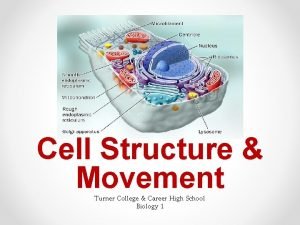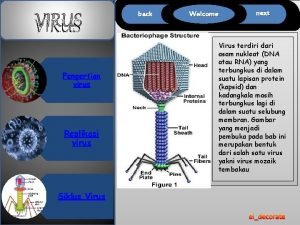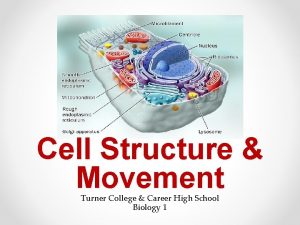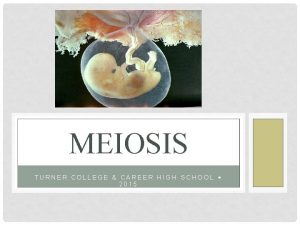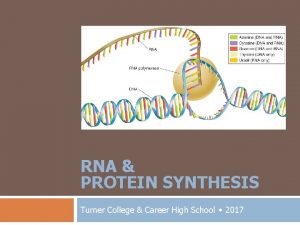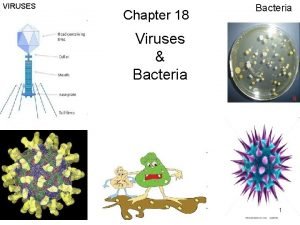VIRUSES Turner College Career High School 2016 Virus












- Slides: 12

VIRUSES Turner College & Career High School 2016

Virus = Virion 1. Living characteristics of viruses: They reproduce at a fantastic rate, but only in living host cells. They can mutate. 2. Nonliving characteristics of viruses They are acellular, that is, they contain no cytoplasm or cellular organelles. They carry out no metabolism on their own and must replicate using the host cell's metabolic machinery. In other words, viruses don't grow and divide. Instead, new viral components are synthesized and assembled within the infected host cell. They possess DNA or RNA but never both. Therefore they are NOT alive!!!

Structure of a Virus A virus particle, or virion, consists of the following: Nucleic acid - Set of genetic instructions, either DNA or RNA, either single-stranded or doublestranded Coat of protein - Surrounds the DNA or RNA to protect it Lipid membrane - Surrounds the protein coat (found only in some viruses, including influenza; these types of viruses are called enveloped viruses as opposed to naked viruses)

Specificity: To Host Cells Viruses are specific to their hosts. □ They can only attack specific cells. □ Rabies, for instance, can be passed from animal to human. HIV is a virus that seems specific to humans. The common cold is a virus that specifically attacks cells of the respiratory track (hence the coughing and sneezing and sniffling). □ Other viruses attack other types of cells. □ □ HIV virus specifically attacks white blood cells.

Bacteriophage Viruses that infect only bacteria. Have a protein "tail" attached to the capsid (protein coat that envelopes the genetic material), which is used to infect the host bacteria. Viruses cannot reproduce on their own, and must infect a host cell in order to create more viruses.

Replication Use their own genetic material and the host cell's machinery 1. Penetration - surface proteins bind to host, and release genetic material (RNA or DNA) into the cytoplasm 2. Replication - the viral genetic material is copied 3. Transcription - the genetic material is used as a blueprint, for the cell to make messenger RNA which is used to make viral proteins 4. Protein synthesis - occurs in the cytoplasm (ribosomes), viral proteins are made 5. Viral Assembly - the viral genetic material (from replication) is surrounded by the newly made viral proteins 6. Release - viruses emerge from the cell by "budding" from the cell membrane or bursting out of the cell (this causes the cell's death)

Lytic and Lysogenic Pathways Lysogenic Pathway - the virus stays within the cell until certain environmental triggers cause it to enter the lytic cycle Lytic Pathway - rapid replication of the virus, ending in cell lysis (or death). More phages are released to infect other cells

Lytic cycle Lytic Cycle The virus reproduces itself using the host cell's chemical machinery. The red spiral lines in the drawing indicate the virus' genetic material. The orange portion is the outer shell that protects it.

Lytic Cycle of a Bacteriophage

Human Immunodeficiency Virus Retrovirus - RNA inside a protein coat HIV infects one particular type of immune system cell, called the CD 4+T cell, also know as a T-helper cell – FX in the body’s immune response. Once infected, the T-helper cell turns into a HIVreplicating cell. There are typically 1 million T-cells per one milliliter of blood. HIV will slowly reduce the number of T-cells until the person develops AIDS.

Statistics Between 36. 7 and 45. 3 million people are infected with the HIV virus worldwide as of November 2005, with as many as 25. 8 million of those cases in sub-Saharan Africa; 2. 1 million were children (2016). Additionally, another 4. 9 million new HIV infections occurred in 2005, which represents almost 14, 000 new cases per day. (Now down to only about 5, 000 new cases per day. ) 1 million died in 2016, bringing the total to about 35 million.

Human Immunodeficiency Virus
 Infinite campus turner
Infinite campus turner Turner college and career high school
Turner college and career high school M7rh5si5154 -site:youtube.com
M7rh5si5154 -site:youtube.com Youtube
Youtube Early college high school at midland college
Early college high school at midland college Asvab cep work values
Asvab cep work values Asvab program fyi
Asvab program fyi Career prep high school shiprock nm
Career prep high school shiprock nm Career orientation program for high school students
Career orientation program for high school students T-stem early college high school
T-stem early college high school Valle verde early college high school
Valle verde early college high school Government organization
Government organization Iechs aspire
Iechs aspire

